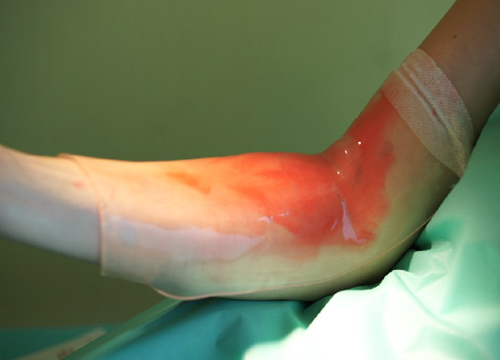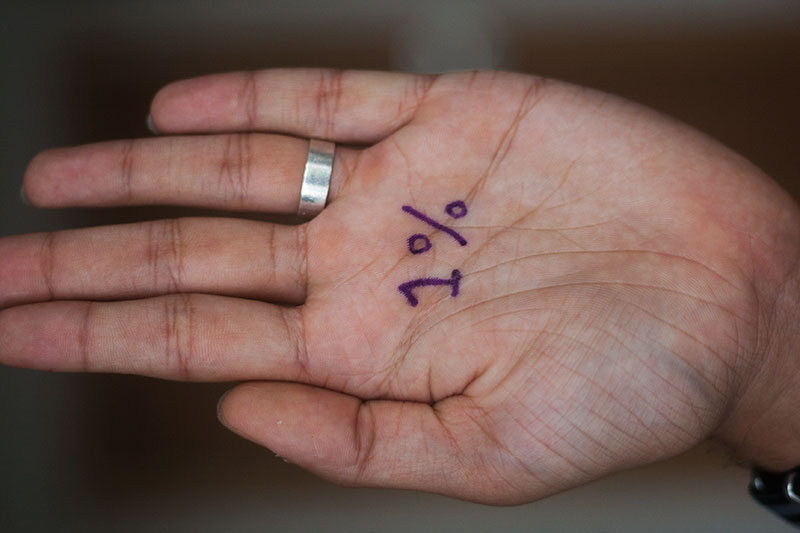Third-degree and more severe burns damage both layers of the skin and may also damage the underlying bones, muscles, and tendons. Injured skin may turn white, black, and/or gray. Sometimes there is no pain because the nerve endings under the skin are destroyed.
Third-degree burns have a high risk of infection. This surgery, done with general anesthesia, removes the injured skin and replaces it with healthy skin from an uninjured area of the body. Full thickness burns that are not grafted may take months or even years to heal. Burn survivors may have a combination of first, second, and third degree burns.
Talk with your health care providers to better understand your specific injuries. Treatment of burns depends directly on the causative agent and degree of injury. Minor burns may be successfully treated at home. Sunburns generally heal within two to five days and can be treated with aloe vera, low dose hydrocortisone creams, and pain medication. Other first and second-degree thermal burns should be immediately immersed in cool water for 10 or more minutes. In chemical burns the causative agent must be neutralized and removed as soon as possible.
Restrictive items such as rings should be removed quickly before the area swells. Over the counter antibiotic ointments may be used. Small blisters should be left intact to heal, while large blisters may require medical removal.
In the event that you suffer a first-degree burn, soak the burn in cool water for about 5 minutes – this helps reduce swelling by pulling the heat away from burned skin. Then, treat the skin with aloe vera or antibiotic ointment and wrap it loosely in a dry gauze bandage. An over-the-counter pain reliever can also help with the pain and swelling.
The recovery and healing time of burns is dependent upon the severity of the individual burn. A second-degree burn is more serious, causing red, white or splotchy skin, swelling, pain and blisters. However, if the burned area is larger or covers the hands, feet, face, groin, buttocks or a major joint, treat it as a major burn and seek immediate medical treatment.
If you think you might have a second-degree burn, you should seek medical care. You should also remove any clothing or jewelry that covers the burn. Cool the burn by running it under cool, not cold, water for no more than 5 minutes.
Do not break open blisters, as this can increase the risk of infection. Many people mistakenly apply ice to burns because it feels soothing, but ice can cause more harm than good in burn cases. Ice should not be applied to burns as it may cause nerve damage and frostbite, especially with more severe burns where the nerve may already be exposed.
Using ice after the initial burn may slow the healing the process further and cause more damage to the surrounding skin. Instead of ice, run cold water over the burn for several minutes following the initial burn. If you are unsure of first aid after a burn, it is always best to seek medical attention. Second degree burns can be extremely painful and create more serious skin damage as they include the epidermis and part of the underlying dermis. The burned area is red, swollen and blistered and may become infected if not properly cared for. These burns can often be treated with basic first aid but depending on their location or size may also require medical attention.
Second-degree burns go through the second layer of skin, called the dermis (DUR-mis). These burns cause pain, redness, and blisters and are often painful. These burns generally do not leave raised scars. Surgery may be necessary for very deep second degree burns or those that are slow to heal. However, the treatment also depends on the size of the burn and its location. You can treat small 1st-degree burns on the hand yourself by holding the wound under cool water for 10 to 15 minutes.
You should then cover the wound, using gauze and a loose bandage. Do not apply ice, butter, egg whites or ointments, since these can worsen the injury and promote infection. If you're experiencing pain, consider taking an over-the-counter pain reliever, such as aspirin, naproxen, ibuprofen or acetaminophen. Do not give aspirin to children under two or to teenagers recovering from chickenpox or flu-like symptoms. First degree and smaller second degree burns are usually managed well at home. First aid may include soaking the burned area in clean cool water for a few minutes to stop the burning process, and then drying gently.
Creams, such as aloe vera or burn ointments may help relieve some of the pain or discomfort. Keep the burns clean and loosely covered, and monitor for breaks in the skin and signs of infection. Antibiotic (an-ti-bahy-OT-ik) ointments or creams are often used to prevent or treat infections in patients with second-degree burns. Using these ointments may require the use of bandages. Your doctor can assist you in coordinating the dressing changes with your pain medication. Dressings can be soaked off with water in a sink or shower.
The skin and the burn wound should be washed gently with mild soap and rinsed well with tap water. Use a soft wash cloth or piece of gauze to gently remove old medications. A small amount of bleeding is common with dressing changes. Your doctor will decide on the appropriate dressing and ointment. This will be based on the location of the burn, the need to control drainage, and your comfort.
Even a small burn has the potential to become infected. It is always advisable to seek medical attention as soon as possible. Delayed treatment may result in more severe complications that could have been avoided with earlier treatment. Furthermore, initial care and treatment of the burn injured patient significantly impacts healing, outcomes, function, appearance, and psychological/emotional adjustment.
The appropriate treatment for a burn depends upon the severity of injury. For more serious injuries, treatment by a multidisciplinary team of trained professionals at a burn center, with special capabilities for managing burns, is essential. First degree burns, often referred to as superficial burns, affect only the epidermis or outermost layer of skin.
When touched, skin that is burned superficially will blanch. The injured epidermis will slough off after a few days. These burns generally heal quickly and do not cause scarring. Ice is not recommended as an initial treatment for burns because it can decrease circulation and make the burn worse.
Do not put any food-based products on the burn as this may cause infection and make it more difficult to clean the wound. Treat small burns with over-the-counter topical antibiotic ointment, like Polysporin or Neosporin, until healed. Burns heal better in a moist, covered environment. To promote healing quicker, use home remedies as soon as possible. These include submerging the burn in cool water for several minutes, applying a topical anesthetic cream or antibiotic ointment, and covering the burn with gauze. If the pain lasts for an extended period of time, take an over-the-counter painkiller.
Third degree burns are serious, regardless of size or area of the body that may be involved, and should be evaluated and treated by a qualified healthcare provider. All third-degree burns should be evaluated by a healthcare provider immediately. Burns that meet ABA burn center referral criteria are not minor burns and require specialized medical treatment. All deep burns require treatment to prevent infection and scarring. Third-degree burns are the most serious type and can be life-threatening. However, first- and second-degree burns are more painful.
If you or a loved one has a blistering burn, prompt medical attention can aid healing. Talk to your healthcare provider about ways to lower your family's risk of accidental burns. Most first-degree burns don't require medical attention, says Bernal. She recommends rinsing the burn area with cool water for five to 10 minutes or until the pain subsides. Next, apply a moisturizing lotion and if needed, take an over-the-counter pain reliever for a few days.
Most minor burns demand little to no medical intervention. When they affect the hands, however, things get a little more complicated. Typically, it's best to seek medical treatment whenever you suffer a burn on key areas of the body, including the eyes, ears, buttocks, genitals, feet or hands. With that being said, you may not need medical attention for small burns on your hand if they aren't covering a major joint. Simply cover severe burns with a clean, moist cloth until examined by a doctor. Third-degree burns can be life threatening and always require skin grafts to heal.
Even severe second-degree burns can cause serious harm. When in doubt, go to your local urgent care or an emergency room to have any burn evaluated. Second degree burns can be serious, especially if they cover a large area of the body. During the summer, most burns are caused by grills, fireworks, campfires and sun exposure. Unfortunately, everyone gets burned at some point.
By and large, most burns don't require treatment at a burn center or need skin grafts, but severe burns requireimmediate medical attention. Cool the burn with running cool water for at least 5 minutes. It is essential when applying water to avoid over-cooling the patient. A clear indication that the patient has been over-cooled is if the victim starts to shiver. Never use ice to cool a burn because this will result in further injury and skin damage to the patient.
Most seriously burned patients are conscious and alert during and after the incident causing the burns, and need to be reassured that they are receiving optimal care. Burns are common personal injuries that can range considerably in severity. Burns are categorized into three degrees based on this severity, with third-degree burns being the most serious distinction that causes the greatest harm.
Understanding the type of burn that occurred can help you determine the type of first aid to apply and the immediacy of help needed. First degree burns are typically superficial skin damages that do not exceed the top layer of skin. First degree burns can be painful but, in most cases, easily treated at home. They are often characterised by pain, redness, slight swelling and dryness but without blisters.
Third degree burns are the ones we worry about because they are more likely to need a skin graft. Any third degree burn should be seen in a burn center to see if it might heal with careful wound care or will require surgery. If the burned skin or blisters have broken open, a bandage is needed. To further help prevent infection, apply a clean bandage whenever your bandage gets wet or soiled. If a bandage is stuck to a burn, soak it in warm water to make the bandage easier to remove. Be sure to read the product label for correct use.
As painful as many 1st-degree burns can be, they can usually be expected to heal with in a 3-7 days from the incident. Immediate soaking of the burn in cool water for five minutes can help to promote healing, as can covering the wound with loose gauze and applying medicated creams. Ibuprofen or acetaminophen can be used to lessen pain/swelling.
These types of burns include damage to the epidermis and dermis. Since the blisters can pop open, they are more prone to infection. They usually take within three weeks to heal and — while there's no scarring — you may notice a difference in skin pigmentation at the site of the wound. They only affect the epidermis and heal within two weeks, without leaving any scars.
Signs include pain, redness, and minor inflammation. As the burn heals, you may also notice peeling skin. While ice is a no-no, "running it under cool water is fine," Gibson says.
But if you're seeking professional medical care, you want to keep the wound clean and dry. "If nerves are exposed to air, it hurts a lot more," she explains. For all burns, any affected skin should be removed from the heat source and cooled with lukewarm or cool water for no more than 5 minutes to stop the injury. Any clothing or jewelry near the site of the burn should be removed. Acetaminophen or an anti-inflammatory such as ibuprofen can help reduce any swelling, redness and discomfort.
Aloe vera gel can help soothe the discomfort, particularly if cooled in the refrigerator, but does not speed healing of burns. Be sure to drink extra water to help your skin rehydrate. Minor burns that have reddened skin similar to a sunburn, should take 3-5 days to heal. Burns that are 2nd degree or partial thickness should be healed within 10 days.




















No comments:
Post a Comment
Note: Only a member of this blog may post a comment.